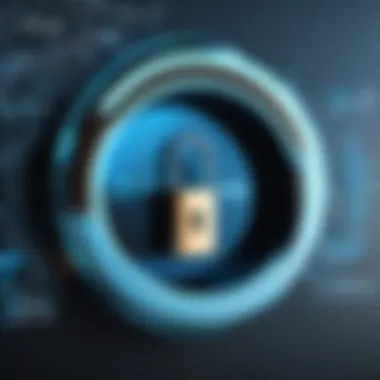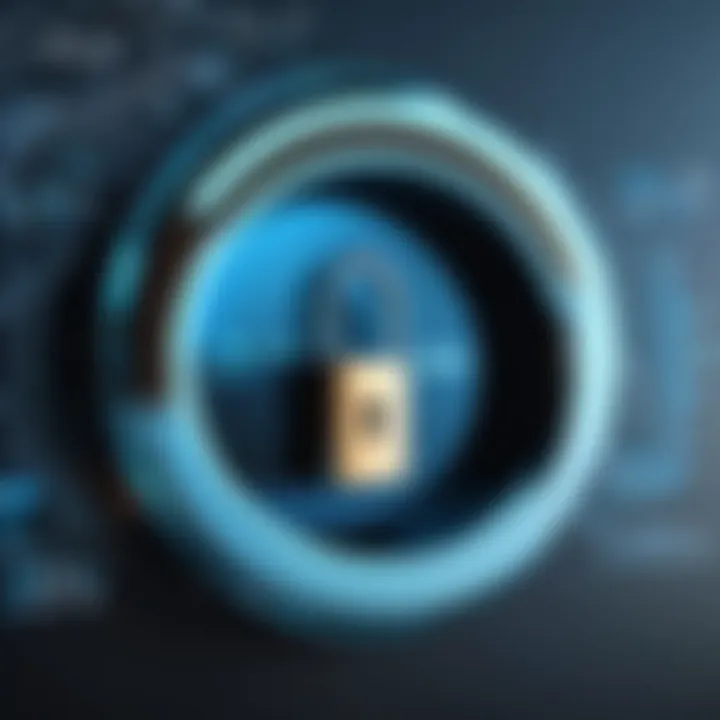Understanding Multi-Factor Authentication for Security


Intro
In today's digital landscape, where safeguarding sensitive information is paramount, Multi-Factor Authentication (MFA) emerges as a pivotal line of defense. It stands as a robust solution against a myriad of cyber threats, fending off unauthorized access through a layered approach that demands multiple forms of verification. This guide is meticulously crafted for decision-makers, IT professionals, and entrepreneurs keen to bolster their organization's security posture.
Understanding the essence of MFA is not trivial; it is intertwined with the shifting paradigms of technology and user habits. As we delve into the components that make MFA effective, we will examine the mechanics behind it, its advantages, and the integration strategies essential for successfully implementing it in various settings. The purpose is clear: equip professionals with the insights necessary for making informed decisions regarding MFA solutions that resonate with their specific needs and challenges.
Key Features and Functionalities
Multi-Factor Authentication isn’t just a buzzword thrown around in tech circles — it’s a well-crafted framework that enhances security through its core functionalities. Let's break these down.
Comprehensive Overview
MFA operates by requiring two or more independent credentials for user authentication. This can include:
- Something you know (like a password)
- Something you have (such as a smartphone app or hardware token)
- Something you are (biometric data like fingerprints or facial recognition)
This layered approach makes it notably more difficult for cybercriminals to breach systems, as gaining access goes beyond simply stealing a password.
Furthermore, MFA can be categorized into two main types:
- Time-based One-Time Passwords (TOTP) - These are typically valid for only a short period.
- Push Notifications - An approach that prompts users to grant access in real-time through their devices.
Target Users
The audience for MFA extends across various sectors, but most notably includes:
- Enterprises with large amounts of sensitive data.
- Financial Institutions managing customer accounts and transactions.
- Healthcare Organizations safeguarding patient information.
- E-commerce Platforms that handle transactions securely.
Each of these entities recognizes the pressing need to enhance security protocols to protect themselves from increasingly sophisticated attacks.
Pricing Models and Cost Analysis
When it comes to implementing MFA, understanding the financial implications is crucial. Different solutions come with varying costs, each designed to cater to specific organizational needs.
Breakdown of Pricing Tiers
- Basic Packages – Typically offer essential features at the lowest price point.
- Standard Packages – Involve mid-level features and integrations, along with some support options.
- Premium Packages – Generally provide advanced features, dedicated support, and custom solutions tailored to unique business requirements.
Pricing can vary significantly based on the service provider, making it essential for businesses to evaluate their needs against available offerings.
Additional Costs to Consider
Beyond the initial investment in MFA solutions, additional costs may include:
- Training Expenses for staff to familiarize themselves with the new processes.
- Maintenance Fees for ongoing support and updates.
- Integration Costs if the MFA solution must be woven into existing systems.
These costs can add up, underscoring the need for thorough planning and budget allocation.
"Adopting Multi-Factor Authentication is not just about compliance; it's about building a culture of security that resonates throughout the organization."
As we move forward in this guide, the next sections will explore integration strategies, the challenges organizations may face during implementation, and practical insights on how to navigate the MFA landscape effectively.
Preface to Multi-Factor Authentication
Multi-Factor Authentication, or MFA, may seem like just another buzzword in the realm of cybersecurity. Yet, its inclusion in security protocols is more than just a trend; it's a vital measure that organizations must embrace. In a world where data breaches and online threats have become everyday occurrences, understanding what MFA entails and how it functions can significantly bolster security frameworks. By requiring user verification through multiple forms of identification, MFA serves not just as a protective layer but as a stronger link against unauthorized access.
The significance of MFA lies in its multifaceted approach to user authentication. Organizations have started to recognize that a single password is no longer sufficient to safeguard sensitive information. This evolution in security awareness reflects an important shift in how organizations perceive their responsibility towards data protection. Moreover, as digital transactions escalate and personal data takes on greater value, so does the urgency to implement more robust security measures like MFA.
Defining Multi-Factor Authentication
MFA refers to an authentication method which requires users to provide two or more verification factors to gain access to a resource—be it an application, online account, or a secure network. The concept hinges on the principle that even if one element is compromised, others remain in place to protect the user’s account and sensitive data. Essentially, MFA combines something you know (like a password), something you have (like a smartphone or authentication token), and sometimes even something you are (like a fingerprint or other biometric verification).
This verification process significantly diminishes the likelihood of unauthorized access. For instance, a hacker who acquires a password won’t readily have access to a second factor, which is typically in the hands of the legitimate user, such as a unique code generated by an authentication app.
The Evolution of Authentication Methods
The journey of authentication methods stretches back decades, evolving from simplistic systems to sophisticated methodologies we see today. In the early days, traditional logins were a mere username paired with a password. This straightforward system, while easy to implement, turned out to be highly vulnerable. Examples abound of data leaks and password breaches before the internet became as intertwined in our lives as it is now. Passwords became less of a safeguard and more of a chink in the armor.
Hence, the need for improved safety mechanisms birthed MFA. Driven by technological advancements and the rise of increasingly clever cyber threats, organizations began to adopt methods that included two-factor authentication (2FA), often combining an email or SMS code with a password.


This evolutionary path passed through various milestones; from the adoption of hardware security keys, such as YubiKey, to implementing biometrics like facial recognition or fingerprints. Each step aimed to address the inherent vulnerabilities present in previous systems, crafting a more fortified approach to securing access to sensitive information. Now, we’re witnessing an acceleration toward even more advanced technologies, such as user behavior analytics, which utilizes machine learning to predict and recognize user engagements, further enhancing the security landscape.
**"As we advance, the blend of technology and user education remains paramount to the successful implementation of MFA."
In summary, entering the age of multi-factor authentication is less about merely keeping up with technological trends and more about the crucial responsibility organizations have in safeguarding sensitive information.
Learn more about authentication processes and their significance in the modern digital landscape.
The Importance of Security in Modern Software
In today's digital landscape, the importance of security in software cannot be overstated. As organizations increasingly depend on technology for their day-to-day operations, the threat landscape grows ever more complex. Security breaches can lead to significant financial losses, reputational damage, and legal ramifications. Therefore, understanding and implementing robust security measures is no longer a choice; it is a necessity.
Common Threats and Vulnerabilities
Organizations face a plethora of threats every day. Common types include:
- Phishing Attack: This sneaky method tricks users into divulging sensitive information by masquerading as a trustworthy source. Awareness is paramount, as even the savviest users can fall for it.
- Ransomware: Imagine this: a malicious actor locks you out of your own data and demands payment for its return. It’s a nightmare that has become alarmingly common and can paralyze an entire organization.
- Insider Threats: Sometimes the danger comes from within. A disgruntled employee or an unwitting accomplice can pose risks that are hard to detect.
It’s crucial to recognize these threats not just as isolated incidents but part of a broader trend that speaks to the vulnerability of current systems. The shift to remote work and cloud solutions has also widened potential entry points for cybercriminals, making the need for a solid security framework even more pressing.
The Growing Need for Enhanced Security Measures
As threats evolve, so too must our defenses. Organizations are being called upon to adopt multi-layered security strategies that include:
- Strong Password Policies: In an era where simple passwords are akin to leaving the front door wide open, encouraging complex, unique passwords is essential.
- Regular Updates and Patching: Out-of-date software is a goldmine for hackers. Regular updates can help safeguard against known vulnerabilities.
- User Education and Training: Even the best systems can fail if users are unaware of potential threats.
"Security is not a product, but a process."
— Bruce Schneier
This quote underscores that security measures must be constantly evaluated and enhanced as new vulnerabilities are discovered. MFA serves as one of the cornerstones of this evolving security landscape. It not only adds an additional hurdle for attackers but also fosters a culture of vigilance within organizations.
Understanding the Mechanisms of MFA
Understanding how Multi-Factor Authentication operates is vital to grasping its role in securing digital spaces. The very essence of MFA lies within its fundamental components, each serving a distinct purpose while jointly fortifying security. This examination empowers IT professionals, software buyers, and decision-makers with the knowledge to implement robust protection for sensitive data.
Types of Authentication Factors
MFA is fundamentally built on three types of authentication factors. Knowing them helps not just in implementation but also in conveying their significance to all users.
Something you know
"Something you know" often pertains to passwords or PINs. It's an essential layer since it’s the first line of defense against unauthorized access. A key characteristic here is familiarity; users tend to feel secure with a password because it's something they can remember, and thus it’s widely adopted.
However, reliance solely on this factor isn’t foolproof. Passwords can be cracked, stolen, or forgotten, making this factor somewhat of a double-edged sword. Its unique role in establishing a baseline of identity cannot be overlooked, but the ever-present risk of a data breach means that strengthening this factor alone is often insufficient for comprehensive security.
Something you have
"Something you have" typically refers to physical devices like a smartphone, smart card, or token. This type introduces a tangible element to the authentication process, heightening security due to its physicality, which makes replication challenging. One of the core benefits of this method is that it provides an additional layer of verification beyond a password.
However, users can face certain challenges. For instance, forgetting a physical token or having it stolen presents significant drawbacks. Moreover, if a user needs to access their accounts from a device without their token, it could become a hassle. Still, despite its limitations, it remains a widely popular choice for enhancing security and reducing the chances of unauthorized access.
Something you are
"Something you are" pertains to biometrics, such as fingerprint recognition, facial recognition, and iris scans. This form of authentication stands out as it involves unique physical attributes inherently tied to an individual. The primary advantage here is the impossibility of losing or forgetting a biometric feature, making it a reliable method for verification.
That said, there are still complications to consider. Some users might have privacy concerns regarding how their biometric data is stored and used. Additionally, the technology isn’t infallible—false positives or negatives can occur, creating potential access issues for legitimate users. Regardless, it continues to be an increasingly adopted option due to its robust security benefits.
The importance of understanding these authentication factors goes beyond knowing their definitions. It’s about strategically deploying them to create a layered security model that can effectively thwart a range of threats.
How MFA Works: A Step-by-Step Breakdown
The operational structure of MFA can be understood by following a straightforward process, which enhances clarity for the end-users and decision-makers alike. The process typically involves the user initiating an action (like logging into an account), where they first enter their password. Then, they receive a prompt for another factor, which could either be a code sent to their device or a biometric scan. Only upon successfully completing this multi-layered verification are they granted access.
By evaluating how MFA works through this step-by-step method, one can appreciate its effectiveness. MFA decreases unauthorized access potential, ultimately leading to improved security of sensitive systems.
Benefits of Multi-Factor Authentication
Multi-Factor Authentication (MFA) isn’t just a tech buzzword; it’s a fundamental shift in how we secure our digital lives. In a world where cyber threats lurk around every virtual corner, the benefits of implementing MFA become increasingly evident. Understanding these benefits is not merely for the sake of knowledge; it’s a call to action for businesses, IT professionals, and decision-makers to prioritize security in their operations.
Increased Security and Risk Mitigation
The most obvious, yet crucial, advantage of MFA is the enhanced security it offers. By requiring more than one method of authentication, systems become less vulnerable to unauthorized access. Think of it as a double lock on your front door. Even if an intruder possesses your password—a detail that’s often stolen or compromised—it won’t be enough to breach your defenses without the second factor.


Key Points on Security Benefits:
- Layered Defense: With MFA, the first hurdle might be something you know, like a password, but the second could be a biometric scan or a temporary code sent to your mobile device.
- Reduced Risk of Data Breach: Organizations implementing MFA have often reported fewer incidences of data breaches and security incidents. Reports indicate that phishing attacks decrease substantially among companies using MFA.
- Adaptability to Threats: MFA allows firms to adapt to evolving threats by integrating new forms of identification as they emerge, keeping security measures fresh and robust.
We can see that multi-factor authentication not only thwarts potential breaches but also mitigates risks effectively, providing a cushion against various sorts of attacks. The lessons learned from previous breaches showcase the necessity of understanding and employing MFA as a go-to strategy for security.
Enhancing User Confidence
User confidence can make or break a digital platform. MFA plays a vital role in bolstering this confidence. When users know that their information is secured with multiple layers of authentication, they feel empowered to engage more fully without fear of identity theft or data compromise.
Benefits to User Perception:
- Trust in the Brand: Users perceive brands that use MFA as more trustworthy. They often feel that their personal information is valued and cared for.
- Increased Engagement: As confidence grows, so does user engagement. Customers are more likely to make purchases, share information, and participate in platforms that they feel are safe.
- Education Through Transparency: When organizations inform users about MFA and its benefits, it encourages user participation in the security process. Users are then more likely to adopt stronger personal security practices.
The relationship between a customer and a company can be fragile. With proactive measures like multi-factor authentication, you not only secure their data but also cultivate a bond of trust.
Regulatory Compliance and Standards
MFA does not merely enhance security; it is increasingly becoming a requirement in many industries, aligning with regulations aimed at protecting sensitive information. For instance, the Payment Card Industry Data Security Standard (PCI DSS) mandates that businesses handling card data employ strong customer authentication methods, which often includes MFA.
Considerations on Compliance:
- Meeting Industry Standards: Compliance with regulations can be intimidating. Many organizations find that implementing MFA brings them closer to meeting these standards, reducing the risk of fines and legal repercussions.
- Facilitating Audits: When regulatory audits approach, having MFA integrated into a security strategy can ease scrutiny. It serves as evidence that a business is committed to safeguarding data.
- Staying Ahead of Legislation: Data privacy laws globally are tightening. By adopting MFA proactively, organizations position themselves as responsible actors in the digital space.
In summary, MFA is more than just a protective measure; it acts as a catalyst for trust, compliance, and enhanced security across digital platforms. For decision-makers, understanding these benefits isn't about keeping up with trends—it's about seizing control of cybersecurity and making informed choices that influence the future of their organizations.
Integration and Implementation of MFA
When diving into multi-factor authentication, it’s easy to get mired in the tech-heavy verbiage and abstract concepts. However, the crux of Integration and Implementation of MFA lies in turning those concepts into practical, real-world solutions. This topic is critical as it focuses on how to effectively weave MFA into existing security frameworks.
Effective integration isn’t simply about slapping an authentication solution onto a system. It involves careful planning, thorough understanding, and strategic choices. The end goal is to achieve an optimal balance between security and user experience. Companies need to consider every aspect, from selecting the right solution to evaluating existing infrastructure.
Choosing the Right MFA Solution
Evaluating Compatibility and Usability
Compatibility and usability can make or break any MFA initiative. One of the pivotal aspects of Evaluating Compatibility and Usability is ensuring that the newly minted authentication system meshes well with existing platforms. Whether a small startup or a conglomerate, the chosen MFA solution ought to facilitate smooth operations rather than disrupt it.
A key characteristic here is the system’s ability to operate seamlessly with various devices and applications already in use. This is a beneficial choice chiefly because it minimizes the likelihood of disruptions during the onboarding phase, fortifying the security without leaving teams trapped in lengthy training.
Unique features like user-friendly interfaces or customizable authentication paths add to its advantages. Conversely, solutions that demand significant system overhauls present a clear disadvantage, often requiring additional time and costs.
Assessing Vendor Reliability
Equally crucial is the Assessing Vendor Reliability. Like picking the right apple from a bushel, not every vendor or product will deliver the quality needed for robust MFA. Vendor reliability plays a vital role in ensuring that businesses aren’t just promised security, but actually receive it.
The key characteristic of vendor reliability is rooted in their reputation and track record in the marketplace. A vendor known for consistent support and updates is more likely to be a frontrunner in this article. Choosing a vendor backed by positive reviews and industry accolades is a popular choice for many, as it signals trustworthiness and stability.
However, one unique feature to consider is the vendor’s approach to customer support. If issues arise, having someone to rely on can make all the difference. On the flip side, opting for lesser-known vendors can lead to unforeseen complications, especially if they lack established support channels.
Steps for Effective Implementation
A successful implementation of MFA involves a systematic approach. Here are the steps to follow:
- Conduct a Risk Assessment: Identify the areas where MFA can mitigate vulnerabilities.
- Engage Stakeholders: Involve key players across departments to gain a holistic view.
- Pilot Testing: Before rolling out widely, conduct tests to iron out any challenges.
- Feedback Loop: Establish a channel for user feedback to enhance usability over time.
- Continuous Monitoring: Keep tabs on the integration and adjust accordingly.
Integrating MFA into Existing Systems
Challenges in Integration
Integrating MFA into existing frameworks isn’t a walk in the park. One of the notable Challenges in Integration is the potential resistance from users. When security suddenly feels cumbersome, it can lead to pushback.
A significant characteristic of integration challenges is rooted in the balance between enhanced security and streamlined usage. It’s vital to communicate the importance of these processes clearly, making users feel as if they are part of the solution rather than subjects of it.
Sometimes, the unique feature of increased complexity can be a double-edged sword. While MFA provides layers of security, it can also lead to confusion or frustrations if not implemented thoughtfully.
Best Practices for Deployment
To smoothly transition into a new MFA system, adhering to Best Practices for Deployment can be a game-changer. The pivotal aspect here is comprehensive user training. Users must understand what MFA is, why it's necessary, and how they can benefit from it.
One important characteristic is ensuring clear communication of benefits and procedures. Often, simplifying the deployment process to create step-by-step guides can ease anxieties around change.


Moreover, incorporating a phased rollout can facilitate a more manageable integration, allowing organizations to evaluate effectiveness incrementally. The unique feature here is flexibility, as it enables pivoting if something doesn’t align during integration.
This comprehensive understanding of the various factors at play in MFA integration will empower organizations and decision-makers to make informed choices, paving their way to a more secure digital landscape.
Challenges and Considerations
In the pursuit of securing sensitive data and digital assets, multi-factor authentication (MFA) presents itself not just as an advantageous solution but also as a set of challenges that organizations need to navigate. Understanding these challenges is crucial because they can influence the user experience, impact costs, and dictate the overall success of MFA implementation initiatives. Recognizing and addressing these aspects is vital for decision-makers aiming to strengthen their security posture while remaining user-friendly.
User Experience and Adoption
When it comes to incorporating MFA, user experience stands at the forefront. If users find the process cumbersome, resistance may grow. Imagine being in a hurry, only to be met with a barrage of authentication steps. A complex MFA setup can turn a straightforward login into a multi-step ordeal, frustrating even the most patient of users. Striking a balance between security and user experience is paramount.
- Simplified Processes: The easier it is for users to navigate authentication methods, the more likely they are to embrace MFA. Biometric methods, such as fingerprint or facial recognition, offer quick access that aligns well with user needs today.
- Education and Training: Engaging users through education can assist in mending potential frustrations. Training them on why MFA matters and how it works can foster a culture of security awareness.
- Feedback Mechanisms: Establishing channels for user feedback can unveil issues with the authentication process early. This allows IT teams to iterate on the system, refining it to meet user needs.
With the right approach, organizations can encourage adoption by making security measures less of a hurdle and more of a seamless addition to user workflows.
Cost Implications and Resource Allocation
Implementing a robust MFA solution isn't merely a matter of installing software. Organizations must allocate resources effectively and consider the financial implications thoroughly. The costs associated with MFA can vary widely depending on the chosen technology and methods.
There are several dimensions to the financial landscape of MFA:
- Initial Setup Costs: Whether it's investing in hardware tokens or software licenses, initial expenses can be significant.
- Maintenance and Upgrades: Ongoing expenses related to system maintenance, updates, and training staff on new protocols should be factored in.
- User Support Services: Supporting users who encounter issues can also incur costs. It's wise to prepare for potential increases in help desk inquiries as users adapt to new processes.
- Long-Term Savings: While the initial investment may feel hefty, many organizations find that they save significantly by reducing the risk of data breaches and cyberattacks, which often come with staggering costs.
Ultimately, framing MFA as a cost-effective solution rather than merely an expense can empower decision-makers. The long-term benefits of safeguarding data and maintaining user trust can justify the investment, aligning with broader strategic goals in the organization.
"Security is not a product, but a process." – Bruce Schneier
By navigating the challenges tied to user experience and cost implications, organizations can embrace a more effective MFA adoption strategy, turning potential obstacles into opportunities for enhanced security and improved processes.
Future Trends in Multi-Factor Authentication
As digital threats continue to evolve, the field of multi-factor authentication (MFA) must also adapt. Understanding the potential future trends in MFA helps organizations prepare for what's ahead. Since decision-makers shape their security strategies based on current technologies, being aware of emerging trends can significantly enhance security posture.
New trends can provide better protection against sophisticated attacks, streamline user experiences, and meet evolving compliance requirements. This section will unfold critical elements shaping the future of MFA.
Emerging Technologies and Solutions
The landscape of MFA is witnessing an influx of innovative technologies. Some of these advancements are transformative, ensuring that security does not come at the expense of convenience. Let's explore a few significant technologies driving change:
- Biometric Authentication: Fingerprints, facial recognition, and iris scans are not just sci-fi fantasies anymore; they are rapidly becoming mainstream. Biometric data offers unique advantages, as it can't be forgotten or lost like passwords. Moreover, it provides a high level of assurance about a user's identity.
- FIDO2 and WebAuthn Protocols: These protocols foster passwordless transaction experiences. FIDO2, combined with WebAuthn, provides users with a strong alternative by using WebAuthn API for authentication. Herein lies the promise of a login experience that is both secure and convenient, where the reliance on passwords could be obsolete.
- Adaptive Authentication: This approach tailors the authentication process based on contextual information like user behavior, geolocation, or device used. If a user, who typically logs in from London, suddenly tries to access an account from Rio de Janeiro, a higher authentication assurance might be triggered.
Companies investing in these technologies will reap benefits in safeguarding sensitive data while maintaining user satisfaction.
The Role of Machine Learning and AI
Machine learning and artificial intelligence are game changers in many realms, and MFA is no exception. The integration of these technologies can elevate security measures remarkably. Here are some ways machine learning and AI are shaping the future of MFA:
- Anomaly Detection: AI algorithms can analyze usage patterns to identify anomalies. If a user tries to log in at an odd hour or from a strange location, the system can require additional verification to ensure security.
- Threat Intelligence: Utilizing AI-driven threat intelligence enhances security models. AI can analyze vast datasets to flag potential vulnerabilities or threats in real time, allowing businesses to respond promptly. This proactive stance is more effective than reactive measures.
- Personalized User Experience: Machine learning can also offer a more personalized experience for users. By analyzing how individuals interact with systems, organizations can tailor the authentication processes, ensuring a balance between security and usability.
"As technology is always evolving, so must the means of securing our digital identities."
These advancements in AI and machine learning will not only strengthen MFA but also adapt to ever-changing user needs and attack vectors, providing a more robust layer of security.
The End
In an era where cyber threats continue to evolve, multi-factor authentication (MFA) stands as a formidable line of defense against unauthorized access. The importance of concluding this discussion on MFA lies in synthesizing the various elements presented throughout the article. By understanding the mechanisms of MFA, its earnest advantages, and the hurdles in its integration, decision-makers can ensure robust security for their organizations.
Summarizing Key Insights
It is essential to reflect on the different facets of MFA that have been explored:
- Definition and Functionality: MFA adds an extra layer of security by requiring multiple types of verification before granting access, making it significantly harder for attackers to penetrate systems.
- Benefits Over Single-Factor Authentication: The added security measures provided by MFA—such as preventing brute force attacks and enhancing resilience against phishing—are critical in our data-driven landscape.
- Challenges in Implementation: While adopting MFA is crucial, organizations must navigate the initial set-up costs, potential disruptions during the transition, and the need for educating users to ensure smooth implementation.
Ultimately, these insights reinforce the notion that MFA is not merely a trend but a fundamental necessity in safeguarding sensitive information in today's interconnected world.
The Essential Role of MFA in Digital Security
Multi-factor authentication serves a pivotal role in enhancing digital security. As organizations increasingly rely on digital platforms for communication, commerce, and collaboration, the stakes for securing access to data have never been higher.
The effectiveness of MFA lies in:
- Diversity of Authentication Factors: Utilizing a combination of something you know (like a password), something you have (such as a smartphone for OTP), and something you are (biometric verification) fosters a multi-pronged approach to security that complicates unauthorized access.
- Fostering User Confidence: When users know their organizations prioritize security, their trust in the platform grows, facilitating smoother user experiences.
- Regulatory Compliance: Many industries are bound by regulations mandating enhanced security measures. Implementing MFA not only meets these requirements but goes beyond, showcasing a proactive approach to data protection.
This reinforces that MFA isn't just an option; it's an essential component of a holistic security strategy that touches on every facet of modern business operations.
In summary, as cyber threats continue to evolve, multi-factor authentication emerges not merely as a security tool but as an essential framework within which organizations can better safeguard their digital domains.















